The Radeon R9 280X Review: Feat. Asus & XFX - Meet The Radeon 200 Series
by Ryan Smith on October 8, 2013 12:01 AM ESTPower, Temperature, & Noise
As always, last but not least is our look at power, temperature, and noise. Next to price and performance of course, these are some of the most important aspects of a GPU, due in large part to the impact of noise. All things considered, a loud card is undesirable unless there’s a sufficiently good reason – or sufficiently good performance – to ignore the noise.
With the Tahiti based 7970GE, we saw AMD push some very high voltages when boosting in order to hit their 1050MHz clockspeed targets. With 280X on the other hand they can back off at least a bit, which should help real world power consumption some.
| Radeon HD 7970/200 Series Voltages | ||||||
| Asus 280X Boost Voltage | XFX 280X Boost Voltage | Ref 7970GE Base Voltage | Ref 7970GE Boost Voltage | Ref 7970 Base Voltage | ||
| 1.2v | 1.2v | 1.162v | 1.218 | 1.175v | ||
On both our stock and factory overclocked 280X cads we see a boost voltage of 1.2v, which as expected is a bit lower than the 1.218v the 7970GE drew under the same conditions.
We also have a quick look at clockspeeds while gaming, although there’s little to report here. Without the ability to see the intermediate clockspeeds on 280X we can only tell whether it’s boosting or not. In every game on both 280X cards, these cards are always in a boost state.
| Radeon R9 280X Average Clockspeeds (Reported) | ||||
| Asus 280X | XFX 280X | |||
| Boost Clock | 1070MHz | 1000MHz | ||
| Metro: LL |
1070MHz
|
1000MHz
|
||
| CoH2 |
1070MHz
|
1000MHz
|
||
| Bioshock |
1070MHz
|
1000MHz
|
||
| Battlefield 3 |
1070MHz
|
1000MHz
|
||
| Crysis 3 |
1070MHz
|
1000MHz
|
||
| Crysis: Warhead |
1070MHz
|
1000MHz
|
||
| TW: Rome 2 |
1070MHz
|
1000MHz
|
||
| Hitman |
1070MHz
|
1000MHz
|
||
| GRID 2 |
1070MHz
|
1000MHz
|
||
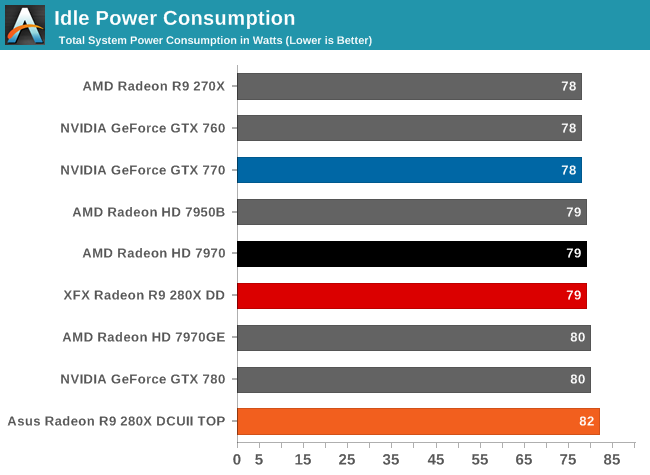
One of the advantages of our new testbed is that IVB-E and the testbed as a whole draw a lot less power under load and idle. This makes it easier to isolate video card power consumption from the rest of the system, giving us more meaningful results.
In this case though there are no surprises to be found with idle power consumption given just how similar all of these cards are while idling.
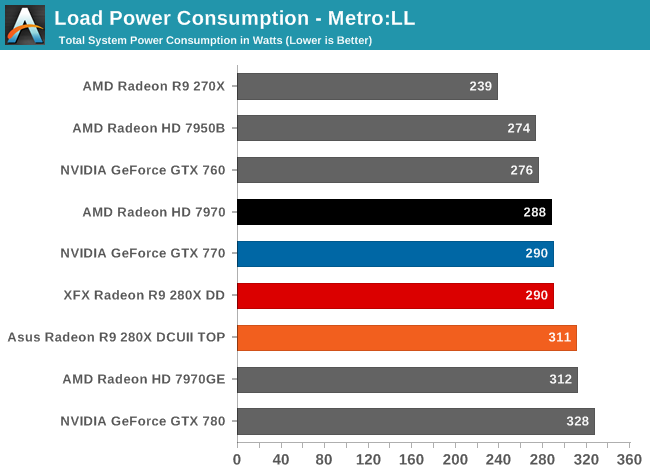
Up next is our new gaming power load test, for which we’re using Metro: Last Light. This was initially calibrated against a GTX 780, in which we found that Metro is both highly repeatable, runs long enough (when looped) to fully exercise a video card, and the load it puts on video cards as a percentage of allowable TDP is considerably average among all games.
To that end Metro paints an interesting picture of power consumption for the 280X. Despite its identical to the 7970GE TDP of 250W, real power consumption is down versus that card, and at least at the wall is identical to the 230W GTX 770 (not that NVIDIA and AMD measure TDP in the same way). What this tells us is that alongside their similar on average performance, the GTX 770 and 280X also draw similar amounts of power under gaming workloads.
Meanwhile Asus’s 280X draws more power, closer to a 7970GE, but this is not unexpected for a factory overclock.
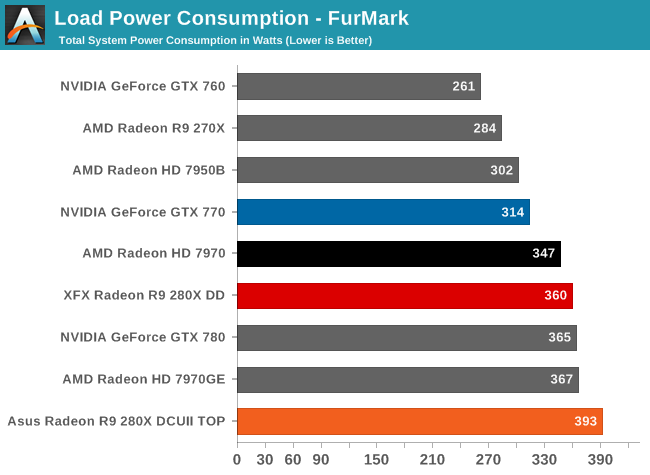
FurMark on the other hand, being the TDP buster that it is, paints a different picture of the situation. The 280X can generate and sustain a much higher power workload than the comparable GTX 770, and still more yet than the original 7970. FurMark isn’t a game and that’s why we primarily use it as a diagnostic tool as opposed to a real world test, but it does lend credit to the fact that when pushed to its limits 280X is still a high TDP part.
At the same time because FurMark is such a consistent TDP test, the outcome of this test leads us to believe that the Asus 280X isn’t just overclocked, but Asus has also increased their TDP/PowerTune limits to avoid bottlenecking there. The power consumption here is consistent with the XFX card having its PowerTune limit turned up, which implies that the Asus card is closer to a 300W card under maximum load. The gaming performance is very good as we’ve seen, but there is a cost.
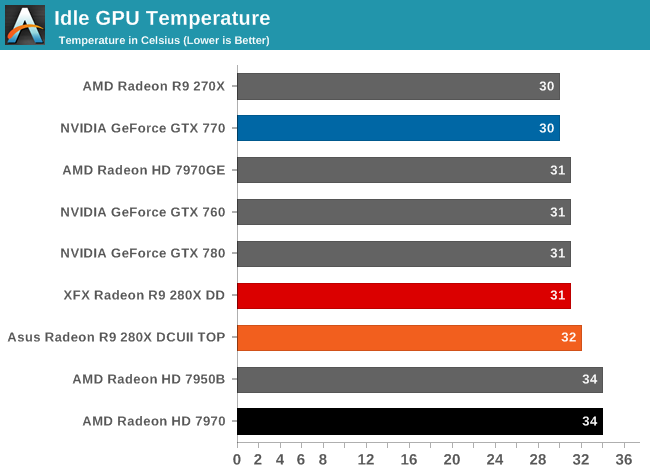
Like most open air coolers, our 280X cards do well enough here. 31C-32C is where most cards will idle at.
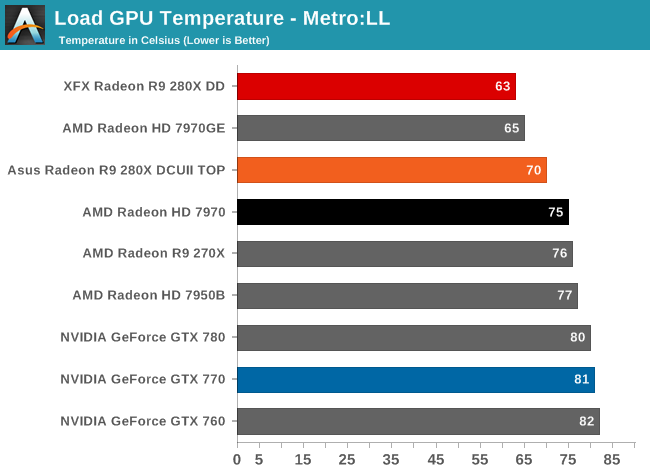
Of all of the Tahiti cards in this article, it’s our XFX 280X that delivers the best temperatures under load. 63 is downright chilly for a 250W card, indicating the card has plenty of thermal headroom. The Asus card by comparison doesn’t fare quite as well, but we don’t even bat an eye until we hit 80C.
It’s worth noting that both cards also do well against the GTX 700 series here, though this is entirely down to the use of open air coolers. As good as these coolers are you won’t be stuffing either card in a cramped case with limited ventilation; for that you need a blower.

As to be expected FurMark drives up our temperatures further. The XFX 280X is no longer our coolest card overall – that goes to the Tahiti based 7970GE – but of the two 280X cards it’s still the cooler one. The Asus meanwhile reaches 76C, which is still a reasonable temperature but it does mean the card doesn’t have a ton of thermal headroom left on its default fan curve. Though if our suspicions are right about the Asus card operating at a higher TDP, then this would at least explain in part the higher temperatures.
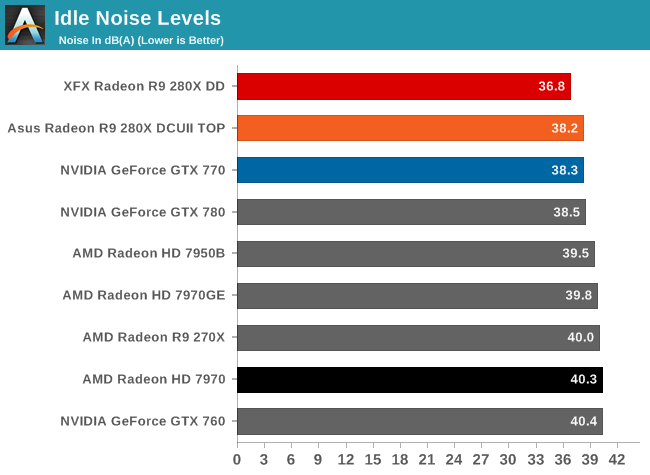
With this being the first article on our new testbed we re-ran the XFX result thrice to make sure we weren’t making any errors, but indeed these results are accurate. Whereas every other card dropped off at around 38dB the XFX 280X bested them with 36.8dB. Even among open air coolers this is a very impressive card at idle. In comparison the Asus is merely average in its near-silence.

Once we start looking at load noise levels however, the picture changes completely. As impressive as the XFX card was at idle, it doesn’t begin to compare to the Asus card under load. We have a card that’s channeling nearly 250W of heat out and away on a sustained basis, and yet for all of that work it generates just 41.5dB(A) of noise on our testbed. This is simply absurd in the most delightful fashion. Most of the cards in our data collection idle at just 2dB lower than this, never mind noise under load. As a result this is incredibly close to being functionally silent; in the case of our testbed the Asus card isn’t even the principle noise source when it’s under load.
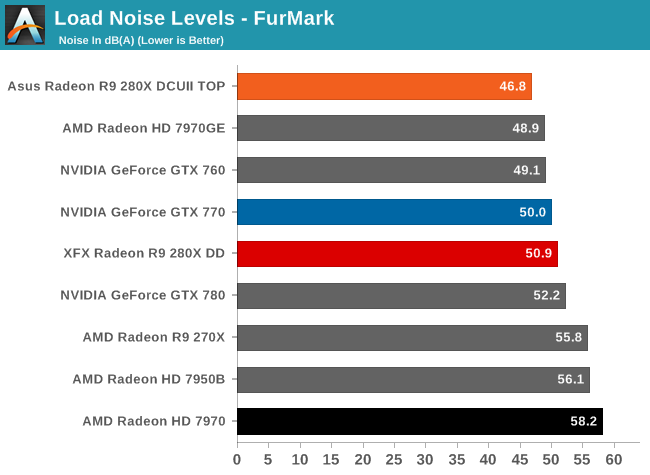
Last, but not least we have noise under FurMark. Although the Asus eventually has to ramp up and leave it’s low-40s comfort zone, at 46.8dB it’s still the quietest card around by 2dB(A). The XFX 280X meanwhile is merely average, if not a tinge worse for an open air cooler. 50.9dB(A) is plenty reasonable, it just pales in comparison to the Asus card.










151 Comments
View All Comments
Dribble - Tuesday, October 8, 2013 - link
Didn't you read the article - it is a 7970GE give or take a little on clocks (depending on what 280 you buy). The only new card is the 290 all the others are the same cards you could already buy. The news is lower prices, although as 7970's were already at lower prices then AMD recommended not sure how much real change there will be.The biggest downer for AMD fans will be the end of the 7950, which was always the price/performance king.
Da W - Tuesday, October 8, 2013 - link
It's gonna be the R9 280 (no X).I might just go and buy two 7950 right now. I'm not sure a single Hawaii priced near a 780 is worth it, crossfire issues notwithstanding.
Very disappointing. Specs I saw floating here and there pointed to 270X being more like a Tahiti XL.
zeock9 - Tuesday, October 8, 2013 - link
Didn't you read my comment - 7970GE can already be had for the same price, so it's the same card for more money because 280X doesn't come with the Never Settle bundle.Trying to charge more buck for less bang just because it has a new name is a effing shame of a business practice.
ninjaquick - Tuesday, October 8, 2013 - link
What do you expect? AMD is not releasing a new architecture this time around. They have a very efficient design in GCN, they will not go changing it. Mark my words, the 370X is going to be a die shrunk 7970 GHz, and the 460X is going to be the same, or just a 'rebadged' 370X. AMD's GCN is a bottom-up modular design, not a top-down big chip first design.HisDivineOrder - Tuesday, October 8, 2013 - link
Mantle is going to require they not stray too far from GCN and the way the cards are currently laid out. Otherwise, you'd have games suddenly having cards they're "Mantle compatible" with and cards they aren't.You won't see huge shifts in how the GCN is laid out post GCN 1.1 if they want to keep low level access working smoothly for the foreseeable future. Then again, perhaps they'll do the shift and just shift back to supporting their high level (drivers) instead once Mantle craters on impact because nVidia and Intel start throwing their money around...
Either way, I'm pretty sure Mantle is a cost-cutting tool to help de-emphasize driver development on the consumer side and help keep up with performance gains by aggressive nVidia and intel release cycles that AMD doesn't have the money to fight.
roastmeat - Tuesday, July 21, 2015 - link
Ha, well what do you knowThe 370 is a rebadge
chizow - Tuesday, October 8, 2013 - link
"AMD has been very explicit in not calling these rebadges, and technically they are correct, but all of these products should be very familiar to our regular readers."So how are these not rebadges/rebrands again and how is it technically correct to not call them rebadges? I just find it funny that AMD was so explicit about not calling them as such, I mean it's clear both parties have a history of rebranding, but let's call a spade a spade here.
Nvidia was pounded by AMD fanboys and the press alike for it's rebranding of G92, but any single iteration from G92 certainly had more changes than the non-existent changes we see with this R7/R9 rebrand stack.
Ryan Smith - Tuesday, October 8, 2013 - link
A rebadge would be something like the 5770 to 6770. Same card, same clocks, same TDP. These are new SKUs, based on existing GPUs, under a new name.chizow - Tuesday, October 8, 2013 - link
lol I guess we have some revisionist history that needs to be written then. Not blaming you of course for public perception, just saying, these were not the standards in G92's day as it easily cleared this very low standard of different clockspeeds/TDP/card design, as every single G92 incarnation surpassed these requirements.In any case, I did appreciate the in-depth coverage of Mantle, possible benefits, repercussions, downsides. Excellent coverage and commentary on all angles, as usual. Look forward to more detail about it in the future.
Gigaplex - Tuesday, October 8, 2013 - link
If the silicon isn't any different, the only distinction is in the board itself and the firmware setting the speeds etc, then it's a rebadge in my books. Nothing stopping OEMs from changing these around, and this does in fact happen with the OC cards. What is the difference between a rebadged chip with an OC vs one of these?